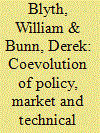| Srl | Item |
| 1 |
ID:
107630


|
|
|
|
|
| Publication |
2011.
|
| Summary/Abstract |
Within the EU, there have been calls for governments to provide greater certainty over carbon prices, even though it is evident that their price risk is not entirely due to policy uncertainty. We develop a stochastic simulation model of price formation in the EU ETS to analyse the coevolution of policy, market and technology risks under different initiatives. The current situation of a weak (20%) overall abatement target motivates various technology-support interventions, elevating policy uncertainty as the major source of carbon price risk. In contrast, taking a firm decision to move to a more stringent 30% cap would leave the EU-ETS price formation driven much more by market forces than by policy risks. This leads to considerations of how much risk mitigation by governments would be appropriate, and how much should be taken as business risk by the market participants.
|
|
|
|
|
|
|
|
|
|
|
|
|
|
|
|
| 2 |
ID:
092743


|
|
|
|
|
| Publication |
2009.
|
| Summary/Abstract |
Carbon pricing is an important mechanism for providing companies with incentives to invest in carbon abatement. Price formation in carbon markets involves a complex interplay between policy targets, dynamic technology costs, and market rules. Carbon pricing may under-deliver investment due to R&D externalities, requiring additional policies which themselves affect market prices. Also, abatement costs depend on the extent of technology deployment due to learning-by-doing. This paper introduces an analytical framework based on marginal abatement cost (MAC) curves with the aim of providing an intuitive understanding of the key dynamics and risk factors in carbon markets. The framework extends the usual static MAC representation of the market to incorporate policy interactions and some technology cost dynamics. The analysis indicates that supporting large-scale deployment of mature abatement technologies suppresses the marginal cost of abatement, sometimes to zero, whilst increasing total abatement costs. However, support for early stage R&D may reduce both total abatement cost and carbon price risk. An important aspect of the analysis is in elevating risk management considerations into energy policy formation, as the results of the stochastic modelling indicate wide distributions for the emergence of carbon prices and public costs around the policy expectations.
|
|
|
|
|
|
|
|
|
|
|
|
|
|
|
|